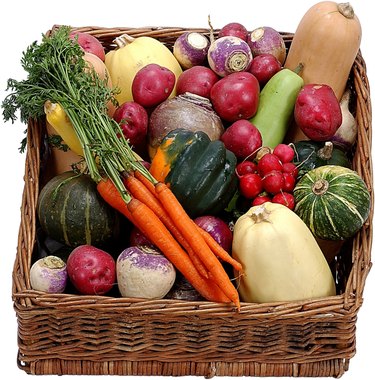
More concerned about their food supply than ever before, Americans have developed an increasing interest in whether pesticides can be found in their vegetables, as well as in organic foods. The United States government strives to keep the food supply safe by setting limits on pesticide use on crops. Unfortunately, methods of testing vegetables for pesticides require cost-prohibitive and sophisticated laboratory equipment. However, you can minimize your exposure to pesticides in vegetables by choosing and preparing foods carefully.
FDA and USDA Inspections
Video of the Day
The Food and Drug Administration and United States Department of Agriculture work together to establish safe limits of crop exposure to pesticides. They establish upper limits on how much pesticide residue is safe for the general public and strictly enforce these levels. These organizations monitor pesticide use on domestic and imported vegetables alike. It is very uncommon to find vegetables with more than a trace of pesticide residue, even among imports. Foods found with unsafe levels of chemical contamination are destroyed immediately.
Video of the Day
Testing Laboratories
Independent testing laboratories offer testing for pesticide residues in plant tissues. Plant material must be handled carefully and frozen as quickly as possible to prevent chemicals from being metabolized. They must then be shipped on ice to a lab. This kind of testing is only useful for vegetables that can be destroyed. It is also cost prohibitive, as testing starts around $100 per sample for a single contaminant. Many labs test only for suspected chemicals rather than generating a list of chemicals found in the plant materials. Laboratory testing is not a practical option for anyone except the commercial farmer.
Limiting Exposure
If you are concerned about pesticides on the vegetables you consume, you can take many precautions to limit your exposure risk. Organic produce is grown without the use of pesticides, theoretically creating pesticide-free vegetables. Chemicals used on long-tended agricultural plots can persist in the soil, but overall pesticide residues of organic produce are extremely low or non-existent. Eating a variety of vegetables also helps to reduce your exposure to pesticides. Vegetable variety literally spreads out your risk by introducing vegetables from different farms and plots that have received a variety of treatments.
Preparing Vegetables
Further minimize pesticide exposure by carefully preparing vegetables that may contain residual chemicals. Scrub vegetables under running water, but do not use soap. Peel vegetables to remove any surface contaminants that may remain. Discard the outer leaves from cabbage and lettuce. Cooking can also break down residual pesticides that may have absorbed into the vegetable in trace amounts.
- Cornell University: Pesticide Residue Monitoring and Food Safety
- University of Florida IFAS Extension: Toxicity of Pesticides
- Oregon State University: Questions About Pesticides in Food
- Michigan State University: Pesticide Residue Testing
- University of Missouri: Pesticide Residue Analysis
- University of Missouri: Pesticide Residue Samples for Drift Incidents
- North Carolina State University: Pesticide Residues in Food: The Safety Issue
- Cornell University: Consumer Concerns About Pesticides in Food
- North Dakota State Univeristy Extension: Pesticide Safety: A Guide for Gardeners and Homeowners
- University of Illinois Extension: Pesticide Residue Testing Labs
- University of Minnesota: Pesticide Residue Testing Labs